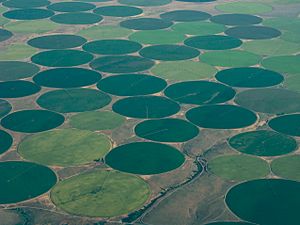Irrigation facts for kids
Irrigation is how we give water to plants. This helps them grow when there isn't enough rain. People get irrigation water from different places. It can be pumped from rivers or natural lakes. Sometimes, water comes from lakes made by dams or from wells deep underground. Water can also flow to fields using pipes or open canals, often just by gravity.
How Farmers Water Plants
There are many ways to water plants for farming. Here are the most common methods:
- Sprinkler irrigation
- Drip irrigation
- Surface irrigation
- Sub-surface irrigation
- Manual irrigation
Sprinkler Systems
Sprinkler irrigation is a bit like natural rain. Water falls onto the plants from above. In this method, water travels through pipes. These pipes lead to sprinklers placed around the field. The sprinklers spray water into the air, which then lands on the plants.
Center Pivot Irrigation
A special type of sprinkler system is called center pivot irrigation. Think of it as sprinklers on wheels. A long pipe with sprinklers rotates around a central point. This creates a large, circular watered area.
Drip Irrigation
Drip irrigation is a very smart way to water plants. Water drips slowly and directly to the roots of the plants. This happens through pipes that have tiny holes or special drippers. These drippers are spaced out along the pipe.
Benefits of Drip Irrigation
Drip irrigation is very efficient. It uses less water than other methods. This is because the water goes right where the plants need it. It also helps keep nutrients in the soil. Plus, it reduces erosion, which is when topsoil washes away.
Surface Irrigation
Surface irrigation is when water covers the top of the soil. This water comes from places like rivers, pipes, or canals. It's a very old method of watering.
When Surface Irrigation is Used
This method uses a lot of water. It can also wash away important soil nutrients. If there's too much water, it can even harm the plants. However, surface irrigation is very common in rice farming. The constant flooding helps control pests. Also, rice plants can grow well in waterlogged soil.
Sub-Surface Irrigation
Sub-surface irrigation is when water comes from below the ground. This method creates an artificial water table. This means water is placed right where the plant roots can reach it.
How Sub-Surface Irrigation Works
Water can seep into the soil from canals that run near or through the farm. Drip irrigation can also become sub-surface irrigation. This happens when the pipes are buried underground instead of on the surface.
Manual Irrigation
Manual irrigation means people water plants by hand. They might use buckets, pipes, or watering cans. This method takes a lot of effort and is not very efficient for large areas.
Effects of Irrigation
Irrigation can help farmers grow more crops on the same land. It also allows crops to grow even during dry times. However, setting up and running irrigation systems can be expensive. Farmers need to make sure the extra crops they grow are worth the cost.
Water Table and Salt
Irrigation can make the water level underground, called the water table, rise. If there's salty water below, it might come up to the surface. Sometimes, the salt level can get so high that it harms or even kills plants. Also, the irrigation water itself can sometimes carry salt or other harmful materials. To prevent this, irrigation projects also need good drainage systems.
Images for kids
-
Young engineers restoring and developing the old Mughal irrigation system in 1847 during the reign of the Mughal Emperor Bahadur Shah II in Indian subcontinent
-
Basin flood irrigation of wheat
-
Crop sprinklers near Rio Vista, California, US
-
A traveling sprinkler at Millets Farm Centre, Oxfordshire, United Kingdom
-
Wheel line irrigation system in Idaho, US, 2001
-
Irrigation is underway by pump-enabled extraction directly from the Gumti, seen in the background, in Comilla, Bangladesh.
-
Sprinkler irrigation of blueberries in Plainville, New York, United States
-
Irrigation in Tamil Nadu, India
-
Irrigation ditch in Montour County, Pennsylvania, USA
-
Water gardens in Sigiriya, Sri Lanka
See also
 In Spanish: Riego para niños
In Spanish: Riego para niños




























